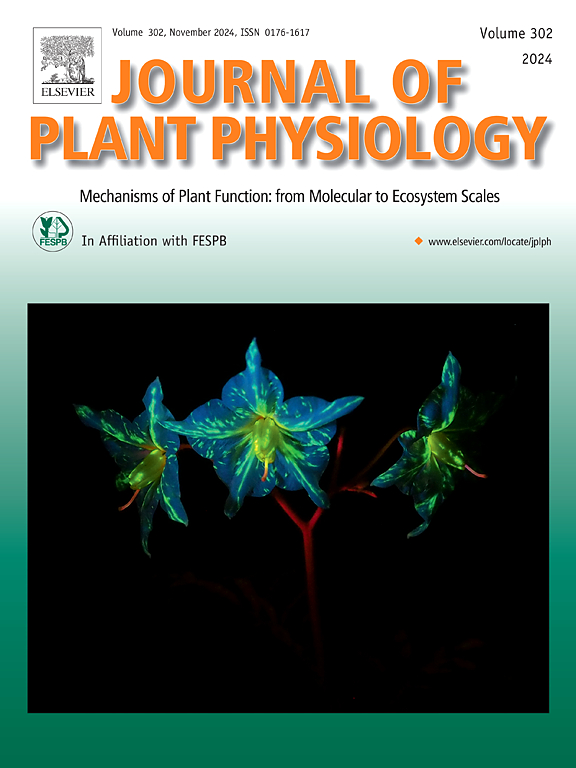Silencing of SbPPC3 reduces the germination capacity in salinity and decreases the nutritional value of sorghum seeds
IF 4
3区 生物学
Q1 PLANT SCIENCES
引用次数: 0
Abstract
Sorghum (Sorghum bicolor L.) is the fifth most important cereal crop worldwide and tolerant to drought and salinity. Phosphoenolpyruvate carboxylase (PEPC; EC 4.1.1.31) is an enzyme playing key roles in seed development and germination. We have previously demonstrated that the silencing of the non-photosynthetic SbPPC3 gene affects plant growth and productivity, delaying flowering, and reducing seed production. In this work, knock-down lines (Ppc3 lines) were used for assessing the contribution of PPC3 to seed filling and germination. PEPC activity was greatly reduced in dry and germinating seeds although the germination capacity was not affected. This could be due to increased phosphorylation of PPC2, the only PEPC isoenzyme co-expressed in the dry seed stage with PPC3. In salinity, PPC2 does not increase its phosphorylation in Ppc3 lines, and silenced lines show lower germination rate. In addition, the survival of seedlings in salinity was reduced to 25% in Ppc3 plants, whereas it remains close to 80% in WT. Thereby, the importance of PPC3 isoenzyme during seed germination in salinity is stablished. The dry seeds of silenced lines show reduced weight, lower starch and fibers levels, and altered energetic state. Despite lower levels of protein compared to WT seeds, Ppc3 seeds showed lower C/N ratio and higher phytate content, indicating alterations in C, N and P metabolisms. These results show that PPC3 activity affects replenishment of seed reserves, thus altering its nutritional value. In addition, they corroborate the relevance of phosphorylation of a starch-storing-cereal seed PEPC during germination.
SbPPC3基因的沉默降低了高粱种子在盐胁迫下的萌发能力,降低了高粱种子的营养价值
高粱(Sorghum bicolor L.)是世界上第五大最重要的谷类作物,耐干旱和耐盐。磷酸烯醇丙酮酸羧化酶;EC 4.1.1.31)是一种在种子发育和萌发过程中起关键作用的酶。我们之前已经证明,非光合作用SbPPC3基因的沉默会影响植物的生长和生产力,延迟开花,减少种子产量。本研究采用敲低系(Ppc3系)来评价Ppc3对种子灌浆和萌发的贡献。干燥和发芽种子中PEPC活性显著降低,但萌发能力不受影响。这可能是由于PPC2磷酸化增加,PPC2是唯一在干种子期与PPC3共表达的PEPC同工酶。在盐度条件下,PPC2在Ppc3系中磷酸化水平不升高,沉默系的发芽率较低。此外,Ppc3植株在盐度条件下的幼苗存活率降低至25%,而WT植株的存活率仍接近80%。因此,Ppc3同工酶在盐度条件下种子萌发中的重要性得到了证实。沉默系干种子表现出重量减轻、淀粉和纤维含量降低、能量状态改变等特点。尽管蛋白质水平低于WT种子,但Ppc3种子的C/N比较低,植酸含量较高,表明C、N和P代谢发生了变化。这些结果表明,PPC3活性影响种子储备的补充,从而改变种子的营养价值。此外,他们证实了淀粉储存谷物种子PEPC在萌发过程中磷酸化的相关性。
本文章由计算机程序翻译,如有差异,请以英文原文为准。
求助全文
约1分钟内获得全文
求助全文
来源期刊

Journal of plant physiology
生物-植物科学
CiteScore
7.20
自引率
4.70%
发文量
196
审稿时长
32 days
期刊介绍:
The Journal of Plant Physiology is a broad-spectrum journal that welcomes high-quality submissions in all major areas of plant physiology, including plant biochemistry, functional biotechnology, computational and synthetic plant biology, growth and development, photosynthesis and respiration, transport and translocation, plant-microbe interactions, biotic and abiotic stress. Studies are welcome at all levels of integration ranging from molecules and cells to organisms and their environments and are expected to use state-of-the-art methodologies. Pure gene expression studies are not within the focus of our journal. To be considered for publication, papers must significantly contribute to the mechanistic understanding of physiological processes, and not be merely descriptive, or confirmatory of previous results. We encourage the submission of papers that explore the physiology of non-model as well as accepted model species and those that bridge basic and applied research. For instance, studies on agricultural plants that show new physiological mechanisms to improve agricultural efficiency are welcome. Studies performed under uncontrolled situations (e.g. field conditions) not providing mechanistic insight will not be considered for publication.
The Journal of Plant Physiology publishes several types of articles: Original Research Articles, Reviews, Perspectives Articles, and Short Communications. Reviews and Perspectives will be solicited by the Editors; unsolicited reviews are also welcome but only from authors with a strong track record in the field of the review. Original research papers comprise the majority of published contributions.
 求助内容:
求助内容: 应助结果提醒方式:
应助结果提醒方式:


